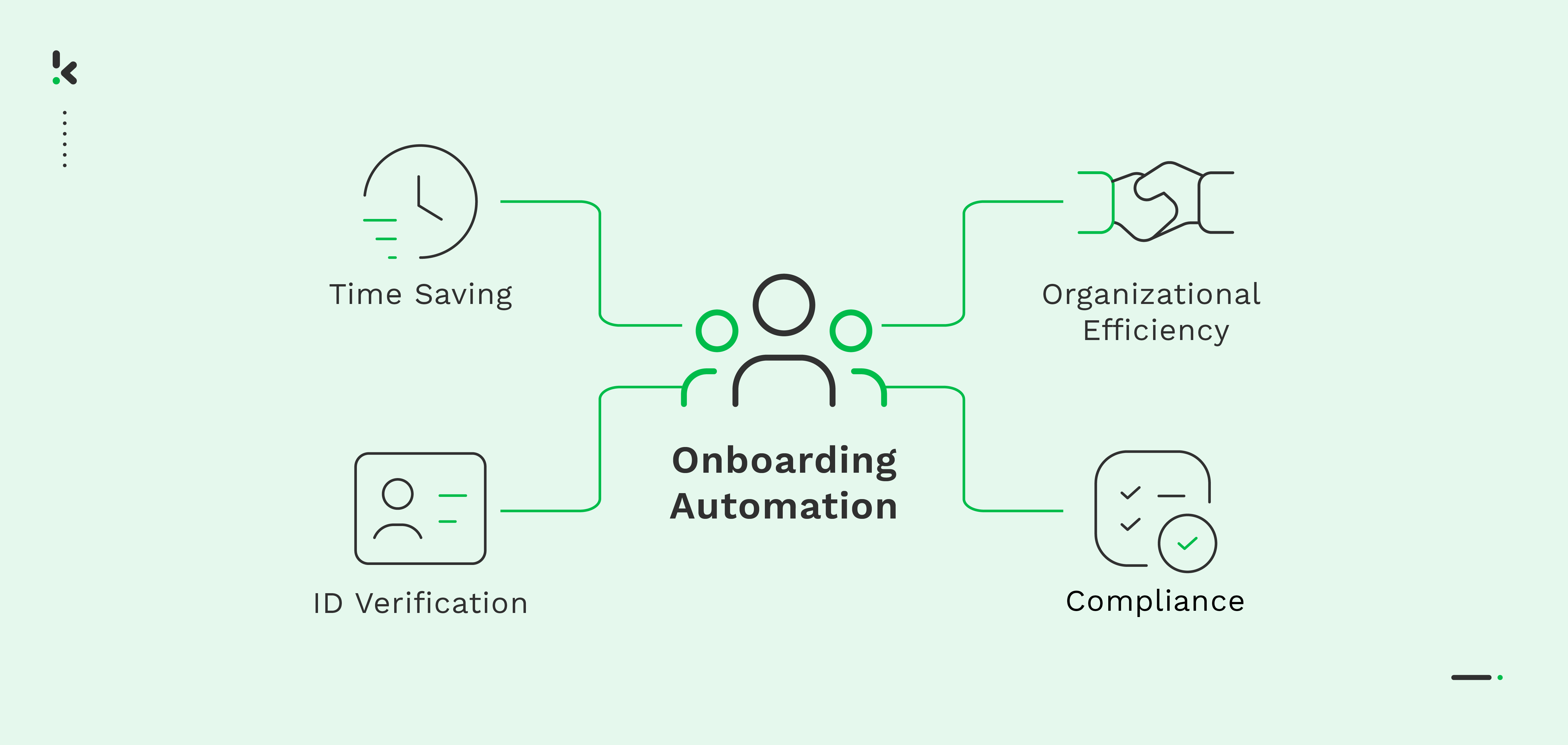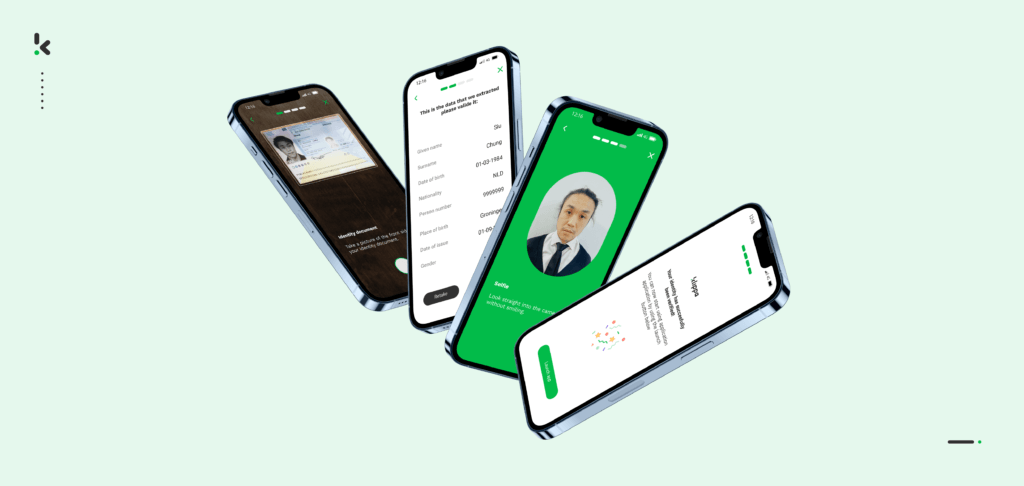

Have you ever found yourself frustrated during a lengthy or complicated sign-up process? Well, imagine if your new customers, patients, or employees experienced the same when you onboard them. Sticking to manual methods not only wastes valuable time and money but also risks leaving those you’re dealing with feeling annoyed. For instance, a 2022 report on the onboarding process found that 21% of consumers have abandoned an application because the process took too long to be completed.
The key here is to leverage onboarding automation. Why? It helps streamline and speed up onboarding processes for higher retention rates while ensuring regulatory compliance. Curious to learn more? Then you’re in the right place!
In this blog, you will learn what onboarding automation is, why it benefits your business, and how it works. Let’s dive in!
What is Onboarding Automation?
Onboarding automation is the process that enables companies to verify individuals’ identities digitally. Therefore, identity verification can be done remotely. It’s typically done through an app or website using methods such as document verification or biometric checks.
You likely recognize the significant impact that automated onboarding has over traditional methods. However, the benefits extend even further. Let’s explore the diverse advantages that onboarding automation offers.
The Benefits of Onboarding Automation
Automated onboarding processes are becoming more of an industry standard, with the ability to enhance the customer experience while improving the efficiency and inner workings of a business. There are many benefits to moving towards automated solutions.
The most impactful benefits include:
- Improved efficiency: Automated onboarding empowers you to reduce manual paperwork and in-person meetings, thus lowering your overhead costs and increasing efficiency.
- Enhanced security: The digital space introduces a variety of smart features like NFC checks or liveness detection. With these identity verification technologies (IDVT), you can ensure a more secure way to onboard newcomers.
- Compliance with regulations: Using automatic ID checks enables you to meet regulatory requirements such as KYC and AML rules efficiently, all while reducing costs and mitigating the risk of severe fines.
- Better user experience: You can seamlessly onboard users with automated onboarding, removing the necessity for them to visit a physical location in person. This means tasks like filling in forms take less time and can be completed from anywhere in the world.
- Increased data accuracy: With OCR technology, you avoid human errors common in manual data entry, ensuring accurate and up-to-date user information.
What are the Use Cases of Onboarding Automation?
Given its numerous benefits, it shouldn’t come as a surprise that onboarding automation can be a game-changer across many industries. In this section, we will explore some of the most impactful real-life applications.
Automated Client Onboarding
Anytime a new client wants to use a service, onboarding is their first step. If you want to provide the best client onboarding experience, you have to ensure that it is as simple and intuitive as possible. And that’s when onboarding automation comes into play.
For instance, in the financial sector, client onboarding is a critical process where digital solutions shine, offering an exceptional combination of security, efficiency, and compliance. People opening an account can easily go through the onboarding process by submitting their documents online to confirm their identity. This not only speeds up the process but also ensures adherence to financial regulations such as KYC and AML.
Automated Employee Onboarding
If you’re searching for a better way of employee onboarding, embracing automated solutions is a sure way to make the process more effective. Picture this, quickly verifying new hires’ identities, finalizing paperwork, and providing access to company systems—all done online.
It’s particularly beneficial for working from home teams and multinational companies, enabling a consistent onboarding experience regardless of geographical location. This approach not only saves time, and resources, and reduces errors but it naturally allows your HR department to redirect their focus towards core tasks.
Automated Patient Onboarding
The healthcare sector can also benefit from automated onboarding by enhancing patient registration and the way they handle data collection processes according to HIPAA. This way, patients can submit their personal information, insurance details, and medical history through secure digital platforms before their appointments, reducing wait times and improving the quality of care.
By now, you should have a clearer picture of how onboarding automation can transcend your processes. Let’s discover the various types of technologies employed for it.
The Types of Technologies Used in Onboarding Automation
Onboarding automation has revolutionized the way businesses and institutions verify and onboard new users, leveraging cutting-edge technologies. Let’s explore these technologies and their roles in the onboarding process.
OCR technology and AI
At the heart of onboarding automation is OCR technology, which allows for the conversion of different types of documents, such as ID cards, passports, and driving licenses, into machine-readable text.
This technology is enhanced by AI to not only recognize and extract text but to also understand and verify the authenticity of the documents. AI algorithms are trained to detect patterns, and anomalies, and to cross-reference information against databases in real-time, significantly reducing the chance of fraudulent activities.
AI Image Recognition
AI image recognition and computer vision technologies play a pivotal role in identity verification during the onboarding process. It involves analyzing facial features from a provided image or video and comparing them against the photo ID documents submitted. Advanced algorithms can detect subtle movements, analyze facial expressions, and even measure the depth of images to prevent impersonation and fraud.
Wireless Connectivity Technology
Wireless connectivity technologies, such as Near Field Communication (NFC) and Bluetooth, further augment the onboarding experience by enabling seamless data transfer and verification. NFC, in particular, is used for secure document checks, allowing users to simply scan their NFC-enabled ID documents against their phone to authenticate their identity. This method is highly secure and efficient, leveraging encrypted data stored on chips within documents for quick validation.
These technologies automate and secure the onboarding process, ensuring a user-friendly and fraud-resistant system. Let’s see it in action! We’ll guide you through a detailed overview of how your onboarding process could look like with Klippa DocHorizon.
How does Automated Onboarding Work with Klippa?
Instead of creating a new solution from scratch, many businesses opt for automated ID verification solutions. Integrating such a solution not only saves time but also ensures ongoing regulatory compliance.
Klippa DocHorizon is one of them. With us, you can make your onboarding process smooth and efficient. We can support you along the way with features that can be highly needed for your onboarding process, and are fully customizable according to your needs:
- Information extraction from identity documents
- Verification of the authenticity of identity documents such as driver’s licenses, ID cards, or passports
- Document classification based on languages or countries
- Supports over 500 ID types across more than 150 countries
- Anonymization of personal data information
- Fraud detection automation with AI
- Biometric verification: selfie and liveness detection
- NFC checks verification
Here is a comprehensive view of our onboarding platform, including a step-by-step verification process.


Step 1: Document Capture
The user uploads or takes a picture with their phone of a government-issued identification document. This could be a passport, driving license, or a national ID card. Klippa provides real-time feedback for capturing a high-quality image of the document using a smartphone or webcam with identity verification SDK.
Step 2: Document Verification
After the document is uploaded, Klippa uses Optical Character Recognition (OCR) technology to extract key personal details from the ID, such as the user’s name, date of birth, and document numbers. Klippa then proceeds to verify the authenticity of the document, checking for any signs of tampering.
Step 3: Selfie Verification and Liveness Detection
During these steps, the user is required to take a selfie. This step is designed to match the user’s live image with the photo on their ID document, further confirming their identity.
Additionally, liveness detection can also be set up. Users are asked to perform simple actions, like blinking or smiling, to verify their liveness and to avoid identity spoofing.
Step 4: Additional Verification Checks
Depending on the service and regulatory requirements, additional verification checks may be necessary.
- Age verification is conducted to ensure users meet any age-related conditions of the service.
- Proof of address might also be requested to confirm an individual’s residence. Typically involving the submission of documents such as utility bills or bank statements. This verification process is commonly encountered within the financial sector.
- NFC ID verification reads encrypted data present in identity document’s chips. This method ensures 100% data extraction accuracy.
Step 5: Verification Outcome
The result of the verification process is communicated to the user.
- If all the checks are successful, the user’s identity is verified, allowing them to access your service.
- If the verification fails, the user is informed of the rejection, with an explanation provided, and possibly the option to retry or submit additional information.
That’s it! Your new users’ identities can be verified within minutes.
Conclusion
Embracing onboarding automation is a strategic move toward improving efficiency, security, and satisfaction in your business processes. It doesn’t even need to be that complicated. If you are ready to streamline your onboarding, contact us or simply book a demo below to see how Klippa can help you.